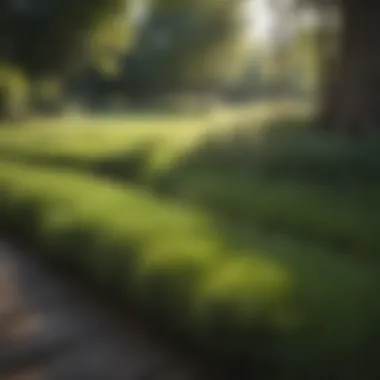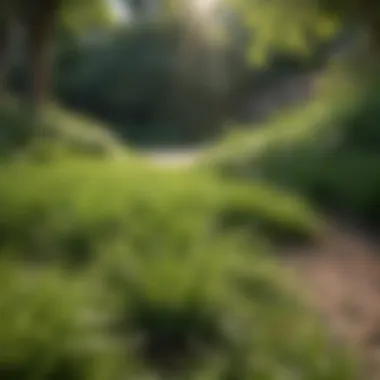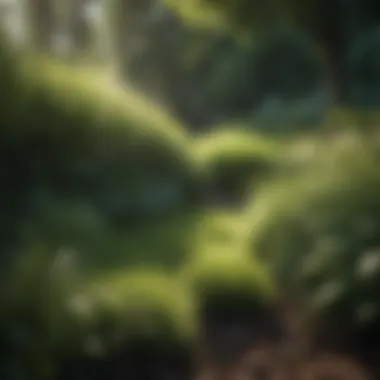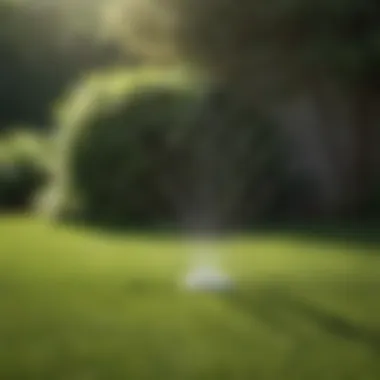Top Grass Varieties for Shaded Areas in NC


Intro
Selecting the right grass for shaded areas in North Carolina can be a daunting task for homeowners and gardening enthusiasts alike. The unique climatic conditions of this region, combined with the challenges posed by low light environments, necessitate an informed approach to ensure a healthy lawn. This article aims to provide a comprehensive analysis of the various grass species that thrive in shaded settings, along with essential care tips and factors influencing their growth.
Understanding the specific needs of grass types suitable for shade is crucial. Not all grass can withstand limited sunlight, and recognizing those that can will greatly enhance both the beauty and functionality of your outdoor spaces. This guide will not only highlight the best options but will also explore effective gardening techniques tailored for shaded lawns.
Understanding Shade in North Carolina Lawns
Shade can significantly influence the growth and health of grass in North Carolina. Identifying how shade affects lawns is crucial for homeowners who want a lush, green landscape. Shade typically leads to a decrease in the amount of sunlight that grass receives. This reduced light mostly influences the grass types that can thrive in such environments.
Furthermore, understanding shade helps in making informed choices about grass selection. Some grasses are more shade-tolerant than others. The region in North Carolina has unique weather patterns that contribute to the extent of shade. Recognizing these factors helps homeowners create a better ecosystem in their yards.
Defining Different Types of Shade
Shade comes in various forms, each presenting distinct challenges and interfaces for grass growth. It is essential to recognize the types:
- Full shade: Areas that receive less than 4 hours of direct sunlight per day fall into this category. Many grasses struggle to survive in these environments.
- Partial shade: This type includes areas that get between 4 to 6 hours of sunlight on most days. Some grass types have a better chance of growing here.
- Dappled shade: This happens when sunlight filters through tree leaves or other obstructions. Grass may find it more favorable, depending on the amount of sun that reaches the ground.
It is important to note that each shade type can impact moisture levels, air circulation, and soil temperature. These elements are key to the overall health of the grass.
Identifying Shady Areas in Your Yard
Pinpointing shady areas in your yard is the first step toward improving your lawn's condition. To determine where shade exists, consider:
- The position of trees and structures: Observe how they cast shadows throughout the day. Trees are a significant source of shade, especially during summer months.
- Time of day: Check different times to see which parts of your yard are consistently shaded. This will help you understand patterns.
- Seasonal changes: Remember that shade can change with seasons. In winter, bare trees can allow more sunlight, while in summer, full foliage may create extensive shade.
- Use tools: Consider using a sun meter to track sunlight exposure over time. This can give you data on exactly how many hours your grass types receive direct sun.
Recognizing shady areas helps in selecting appropriate grass species and can lead to better overall lawn health.
Key Factors Impacting Grass Growth in Shade
Understanding the key factors that impact grass growth in shade is critical for homeowners and gardening enthusiasts in North Carolina. The unique environmental scenarios presented by shaded areas necessitate a tailored approach to lawn management. Here, we will explore the soil type and quality, moisture levels, and temperature variations that define these shaded environments and influence grass growth. Recognizing these elements allows individuals to select appropriate grass types and implement effective care strategies that promote healthy lawns.
Soil Type and Quality
The type and quality of soil play a fundamental role in the growth of grass in shaded areas. Different grasses have varying requirements for soil composition. Generally, loamy soil is ideal, as it retains moisture while providing adequate drainage. In shaded areas, the presence of organic matter is crucial. Natural compost can significantly enhance soil structure and nutrient content, promoting better grass health.
Moreover, soil pH affects nutrient availability. Most grass types prefer slightly acidic to neutral pH, approximately between 6.0 to 7.0. Testing soil pH is a simple yet often overlooked practice. Homeowners should consider adjusting pH levels by incorporating lime or sulfur, depending on the results, to create a suitable environment for grass growth.
Moisture Levels
Moisture levels are another vital factor affecting grass growth under shade. Shady areas often experience reduced evaporation, leading to higher moisture retention. While this can be beneficial, excessive moisture may lead to problems like root rot and fungal diseases, particularly in cool and damp conditions. Therefore, understanding the balance of moisture is essential.
Regularly monitoring soil moisture through a simple finger test can help. Insert a finger into the soil about two inches deep; if it feels dry, it’s time to water. Conversely, overwatering can suffocate roots and hinder growth. Implementing a smart watering schedule tailored to local climate conditions can make a significant difference in maintaining optimal moisture levels.


Temperature Variations
Temperature variations are another factor influencing shade growth. North Carolina often experiences humid summers, meaning shaded areas can be cooler than sunny spots. Yet, in winter, shaded grass may remain colder longer, delaying growth. Different grass types respond differently to these temperature variations.
For instance, Tall Fescue thrives in cooler temperatures and is drought-resistant, making it a suitable option for many shaded areas. Conversely, Zoysiagrass prefers warm conditions and may struggle in prolonged shade. It’s essential to choose a grass type that aligns with the specific temperature conditions of your shaded area to ensure vigorous growth throughout the seasons.
"Consider your unique environmental conditions. The right soil, moisture, and temperature factors are essential for successful grass growth in shade."
By considering soil type and quality, maintaining appropriate moisture levels, and being aware of temperature changes, homeowners can make informed decisions when selecting grass for shaded areas. These factors are not just scientific points; they inform practical choices that lead to lush lawns and enjoyable outdoor spaces.
Types of Grass for Shaded Areas
Choosing the right type of grass for shaded areas is vital for maintaining a healthy and attractive lawn in North Carolina. Given the specific conditions provided by shade, certain grass species will perform better than others. Understanding these options enables homeowners to select grass that not only survives but thrives in low-light environments. This section emphasizes the unique characteristics and benefits of various shade-tolerant grass types.
Tall Fescue
Tall Fescue is a highly adaptable grass type, making it a top choice for shaded regions in North Carolina. This type has a deep root system, allowing it to reach moisture below the surface, ideal in conditions where rainfall might be sporadic. Additionally, Tall Fescue exhibits excellent drought resistance, meaning it can survive periods of low water, a common issue in shaded areas.
The grass has a coarser texture compared to other species, yet it provides a dense green cover, enriching the appearance of any yard. Importantly, it can tolerate a range of temperature variations, equipping it to survive in North Carolina's fluctuating climate. Moreover, Tall Fescue is suitable for moderate foot traffic, which enhances its appeal for active households.
Perennial Ryegrass
Perennial Ryegrass is another suitable option for areas with shade. It germinates quickly, sometimes sprouting in as little as five to ten days, which is particularly beneficial for quick patching and overseeding. This grass type has a fine texture that gives a smooth finish to lawns. Although it prefers well-drained soil, Perennial Ryegrass can manage in partially shaded conditions, making it a practical choice.
However, this species is less tolerant of extreme heat and drought. Therefore, careful monitoring of soil moisture is necessary, especially during the hotter months. The attractive color and lush growth can also contribute positively to the overall aesthetics of your lawn.
Kentucky Bluegrass
Kentucky Bluegrass is renowned for its lush, vibrant appearance, making it a popular choice in North Carolina. It spreads through underground rhizomes, which helps fill in gaps and creates a thick lawn. However, Kentucky Bluegrass has specific requirements. It thrives in full sun but can adapt to shaded environments with proper care.
This grass demands higher moisture levels and does not fare well in drought conditions. It is essential to ensure adequate watering, especially during dry spells. Additionally, it may require more frequent fertilization compared to other grass types to maintain its vibrant color and health. Understanding these care requirements is crucial for homeowners looking to keep Kentucky Bluegrass in shaded areas.
Zoysiagrass
Zoysiagrass is a versatile and hardy turf option suitable for shaded lawns. This grass is heat and drought-resistant, which makes it well-suited for North Carolina's humid climate. It grows well in partial shade and can adapt to various soil types.
Zoysiagrass has a slower establishment rate than the previously discussed types, but once established, it develops a thick, dense mat, providing good wear resistance. It can withstand moderate foot traffic, making it ideal for residential areas that experience activity. The trade-off is that Zoysiagrass may require more patience initially but offers durability and longevity in the long term.
Choosing the Right Grass for Your Lawn
Selecting the appropriate grass for shaded areas in your North Carolina lawn is essential. Not all grass types possess the necessary traits to flourish in low light conditions. The right selection not only ensures a lush, green appearance but also contributes to the overall health of your lawn. By carefully considering factors such as sunlight availability, foot traffic, and aesthetic desires, homeowners can cultivate an attractive and sustainable lawn.
Assessing Sunlight Exposure


Understanding how much sunlight each area of your yard receives is critical. Sunlight exposure varies significantly even within small distances. You will need to identify how many hours of direct sunlight and indirect light your shaded area gets daily. Using a sunlight meter or simply observing your yard can help quantify this.
Here are some classifications you might encounter:
- Full Shade: Less than 4 hours of direct sunlight. Grass types that thrive in complete shade need to be exceptionally tolerant.
- Partial Shade: 4 to 6 hours of sunlight. Grass in these areas may have better options than those in full shade.
- Dappled Shade: Intermittent sunlight, often influenced by trees or structures. Grass can perform effectively if chosen wisely.
An awareness of sunlight exposure will influence your final choices and help avoid disappointing results.
Considering Foot Traffic
In North Carolina, lawns often experience varying levels of foot traffic, which can greatly affect grass types' health and durability. Lawns utilized more frequently for walking, playing, or entertaining need grass varieties that can withstand wear and tear.
Grass types suitable for high foot traffic include:
- Tall Fescue: Known for its tolerance to drought and wear; suitable for active areas.
- Zoysiagrass: Dense and resilient, Zoysiagrass handles pressure well.
When estimating foot traffic, consider how you use the yard. If an area is rarely used, you may prioritize aesthetics over durability.
Evaluating Aesthetic Preferences
Visual appeal, while subjective, is important in landscaping choices. The texture, growth habit, and overall color of the grass contribute to your lawn's aesthetic. Think about how the grass will complement your home's architecture and any surrounding plants.
- Tall Fescue: Offers a coarse texture and deep green color. Provides a robust and textured lawn.
- Kentucky Bluegrass: Popular for its rich color and fine-bladed texture, it can create an elegant look.
- Perennial Ryegrass: Known for quick establishment and a lush, uniform appearance.
Design considerations should align with functional needs while contributing to the home's overall attractiveness.
Caring for Shade-Tolerant Grass
Caring for shade-tolerant grass requires distinct strategies that differ from traditional lawn care in sunny areas. This segment delves into the primary considerations that influence the health and vitality of your shaded lawn. Understanding these elements not only promotes a lush green appearance in low light but also enhances the durability of the grass varieties suited for these environments. The subtleties in care can lead to significant differences in growth, resistance to pests, and overall lawn appearance.
Watering Techniques
Watering is one of the most essential factors for maintaining healthy shade-tolerant grass. Grass types like Tall Fescue and Zoysiagrass thrive with specific moisture requirements. Grasses in shady areas typically require less frequent watering than those in full sun, due to reduced evaporation and cooler ground temperatures.
- Frequency: It is recommended to water deeply but less often, allowing roots to grow deeper into the soil. Check the soil moisture before watering. If the top inch is dry, it is time to water.
- Timing: Early morning watering is best. This minimizes evaporation and allows grass blades to dry out before evening, reducing the risk of disease.
- System Type: Consider using a drip irrigation system for consistent moisture levels without oversaturation, which can lead to root rot or fungal issues.
Fertilization Practices
Fertilizing shade-tolerant grass is another vital aspect of care. Different grass types have varying nutrient needs. Here are a few best practices:
- Soil Test: Before applying fertilizer, conduct a soil test to determine nutrient deficiency. This helps to use the right type and amount of fertilizer.
- Organic Options: Organic fertilizers like compost can improve soil structure and microbial activity while providing nutrients over time. This is especially beneficial in shaded areas where soil might be compromised.
- Timing: Apply fertilizers at the beginning of the growing season. This aligns the nutrient boost with the grass’s growth cycle. Avoid late-season fertilization as it can encourage growth that will not survive winter.
Mowing Strategies


Mowing might seem straightforward, but it requires strategic thought in shaded lawns. Here are some key strategies:
- Height: Mow at a higher setting. Keeping grass blades taller allows for more photosynthesis, promoting healthier growth even in low light.
- Frequency: Mow regularly to avoid cutting more than one-third of the grass height at once, which can stress the plant.
- Sharp Blades: Always use sharp mower blades. Dull blades rip the grass, making it more susceptible to disease.
- Pattern Change: Change mowing patterns periodically. This prevents soil compaction and promotes healthy growth by minimizing wear on the grass root systems.
Proper care for shade-tolerant grass can create a vibrant lawn while ensuring resilience against environmental challenges. Understanding and implementing these practices will lead to a robust shaded lawn that enhances the landscape in North Carolina.
Common Challenges with Shaded Lawns
In many parts of North Carolina, shaded lawns present unique challenges that homeowners must navigate to maintain a healthy and appealing landscape. These challenges can significantly affect the health of the grass and the overall aesthetic of the lawn. Understanding these issues is essential for successful lawn care, especially in shaded areas where competition for nutrients and sunlight can be fierce.
Pests and Diseases
Shaded lawns are often more prone to various pests and diseases. The denseness of shade creates a humid environment, which is conducive for fungal infections. Some common lawn diseases such as brown patch and Pythium blight thrive in these conditions.
- Identification: Homeowners should look for signs of discoloration, patchiness, or excessive moisture retention. These could be symptoms of underlying issues like inadequate airflow, which encourages fungal growth.
- Management: Regular monitoring is vital. Cultural practices like proper watering techniques can minimize moisture on blades and in the soil. Selecting disease-resistant grass types can also help to combat these issues over time.
Compacted Soil Issues
Compacted soil is another hurdle that often appears in shaded areas. High foot traffic combined with trees and shrubbery can contribute to hard soil conditions, limiting grass roots' ability to penetrate the soil effectively.
- Symptoms of Compaction: Homeowners may notice poor drainage, reduced growth of grass, or even bare patches. These signs often indicate a need for soil testing and remediation.
- Solutions: Aeration techniques, such as mechanical aeration, can be employed to alleviate soil compaction. This technique allows better air circulation and enables roots to grow deeper. Adding organic matter can improve soil structure and nutrient levels.
Maintaining Healthy Grass Cover
Achieving and maintaining a healthy grass cover in shaded areas is no easy feat. Grass species that tolerate shade often grow slowly and require specific care to thrive.
- Regular Maintenance: Lawn care in shaded regions involves proper mowing heights, fertilization, and adherence to a consistent watering schedule. Mowing too low can stress shade-tolerant grass, compromising its health.
- Best Practices: Focus on fertilizing with slow-release fertilizers to provide nutrients over time. Monitoring light conditions is also important. Adjustments to surrounding trees can sometimes help improve light access without dramatic landscaping changes.
In summary, understanding and addressing the common challenges in shaded lawns is crucial for homeowners in North Carolina. By being aware of pests and diseases, managing soil compaction, and maintaining healthy grass cover, homeowners can cultivate a vibrant lawn even in low-light conditions.
Closure and Best Practices
The conclusion of this article serves as a crucial element to encapsulate the insights and practical guidance on cultivating shade-friendly grass in North Carolina. A well-maintained shaded lawn can be an asset to any property, providing aesthetic appeal and functional outdoor space. By understanding the challenges posed by shaded environments and selecting the right grass type, homeowners can significantly enhance their landscaping.
Summarizing Key Points
In this article, we explored various facets of grass growth in shaded areas. Key takeaway points include:
- Types of Grass: Tall Fescue, Perennial Ryegrass, Kentucky Bluegrass, and Zoysiagrass are the top contenders for low-light conditions. Their varying characteristics make them suitable for different circumstances.
- Growth Factors: Pests, soil quality, moisture, and temperature all play vital roles in the health of grass in shady areas. Understanding these factors can help in making informed decisions on maintenance and care.
- Care Practices: Regular watering, appropriate fertilization, and correct mowing techniques are essential to keeping grass healthy. Implementing these practices specifically for shaded environments can lead to improved outcomes.
By focusing on these points, readers can develop a clearer understanding of how to establish and maintain beautiful shaded lawns.
Recommendations for Homeowners
For homeowners looking to cultivate a thriving shaded lawn, consider the following recommendations:
- Conduct a Soil Test: This will give you insight into the nutrient content and pH of your soil, allowing for tailored fertilization.
- Select the Right Grass: Choose from the specified grass types based on your yard’s light conditions and intended use. For areas with moderate shade, Tall Fescue may be appropriate, while Perennial Ryegrass suits those with frequent foot traffic.
- Water Wisely: Ensure proper irrigation practices that account for your grass's water needs without over-saturating the soil, which can lead to disease.
- Regular Maintenance: Schedule frequent checks on the health of your lawn. Addressing issues such as pests, compacted soil, or any signs of disease early can prevent larger problems down the road.
- Stay Informed: Utilize resources such as forums or gardening websites like reddit.com for tips from fellow enthusiasts, and consult expert literature to stay updated on best practices.
By adhering to these recommendations, homeowners can not only enjoy a healthy lawn but also contribute to the overall beauty of their outdoor environment.



